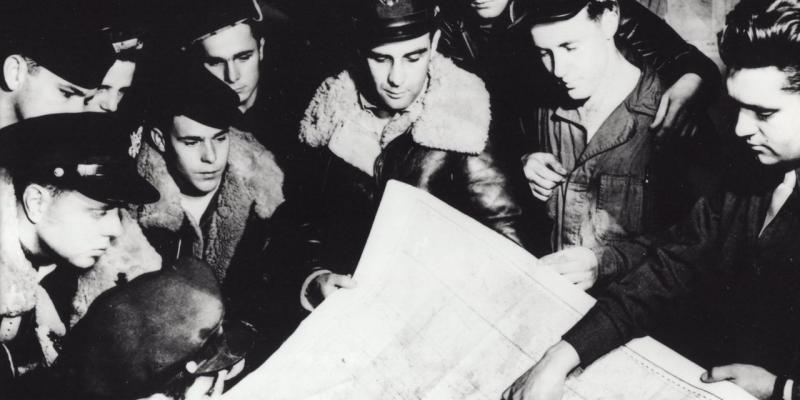'Luck of the Draw' Review: The View From the Fortress
By: Daniel Ford (WSJ)



Frank Murphy was born in 1921, which turned out to be bad luck. His was the generation that served as cannon fodder for World War II.
Murphy had a solidly middle-class upbringing in Cleveland and Atlanta, despite the Great Depression. He was a Boy Scout, graduated from a Catholic military school and enrolled at Emory University. Hooked on the stories of aces on the Western Front during World War I, he even took flying lessons and soloed in a Piper Cub. "If we were missing anything in life, we were not aware of it," Murphy writes of his youth in "Luck of the Draw: My Story of the Air War in Europe." Originally published in 2001, Murphy's memoir has been republished with the help of his daughter Elizabeth Murphy and granddaughter Chloe Melas.
Frank Murphy, who died in 2007, was 20 when the attack on Pearl Harbor catapulted his country into the world-wide conflagration. He promptly signed up for Army flight training. Like many starry-eyed young men, he wanted to be a pilot—but faulty depth perception and a knack for numbers shuttled him into navigator school, and from there to the crew of a Boeing B-17F, known as the Flying Fortress. The name stemmed from a prewar delusion that afflicted air forces around the world: As the Saturday Evening Post put it, the B-17 battle plane could supposedly “drop a bomb into a pickle barrel from 18,000 feet” while flying so high and fast that it had little to fear from enemy interceptors or antiaircraft guns. By 1942 most air forces had learned better.
Still, the B-17 was a magnificent bomber—beautiful, tough and bristling with half-inch machine guns, one of them manned by the navigator from his perch in the bomber’s plexiglass nose. After training for more than a year, in the spring of 1943 Crew 31—with its six sergeants and four officers, including Lt. Murphy—was deemed ready for combat. For Murphy, flying to Europe was his first serious test: He navigated his crew across the North Atlantic from Labrador to Cape Farewell at the southern tip of Greenland, then on to Iceland, Scotland, and down the English coast to the concrete runways of Thorpe Abbotts in Norfolk.
Murphy and his crew received their baptism by fire on June 28. It began with another challenge for the young navigator: South from England’s Land’s End, around France’s Brest Peninsula, then through the Bay of Biscay to attack the German submarine base at Saint-Nazaire in southwest France. The U.S. Eighth Air Force called Saint- Nazaire Flak City for its black clouds of shrapnel-filled smoke from the base’s dreaded batteries of 88mm guns—“flak” being the German acronym for antiaircraft cannon. “It horrified me,” Murphy admits:
When we entered the flak, it was an almost uninterrupted cloud of swirling black smoke filled with angry red explosions. Plainly, any one of those exploding shells could obliterate an aircraft and its crew. . . . My heart felt as if it would stop. It did not appear possible that anyone or anything could fly into that hell and come out alive on the other side. But somehow, despite being buffeted by thunderous explosions and the incessant clinking, clanging, and pinging of shell fragments striking our airplane, we made it through.
Perhaps the worst part was that there was nothing for Murphy to do on his way through the flak. There was nothing anyone could do, for Crew 31 was part of a tight formation, held together by the supersecret Norden bombsight that controlled the plane’s autopilot and kept them on the straight and level until the bombs were away.
Happily, Crew 31 met no German fighters during that mission to Flak City. In the war’s early years, the single-engine Messerschmitt and Focke-Wulf interceptors were among the best in the world, as were their pilots. They usually attacked head-on, Murphy recalls:
. . . the muzzle flashes of the guns in the leading edges of their wings twinkling like Fourth of July sparklers, gray-white puffs from exploding time-fused 20mm cannon shells into and through our formation. The German pilots were highly determined, skilled, and courageous; their fighters seemed to slip and slide through openings and cracks in the sky between our aircraft, or half-rolling and snapping into a power dive straight down.
At such moments, the navigator was but another machine gunner, like the sergeants crouching in the B-17’s defensive turrets or manning the waist guns.
In most air forces, an airman flew until he died or was promoted to a staff job. The Americans, however, usually did a “tour” of 25 missions before going home to train a new crop of airmen. By the end of July 1943, the Eighth Air Force was suffering a loss rate of 4% per mission. “This meant that a crew member’s chance of completing his combat tour was statistically zero,” Murphy writes.
On Sunday, Oct. 10, 1943, Murphy enjoyed a precombat breakfast—real eggs!—and was briefed for his 21st mission, an attack on the railyards of Münster in northern Germany, some 35 miles from the Dutch border. Given the limited range of fighter planes in those days, Crew 31’s fighter escort was to turn back just short of reaching the target. The plan seemed safe enough, but the mission became “one of the greatest air battles in history” in terms of the number of aircraft deployed and the ferocity of the engagement. Crew 31 was among the victims, shot down soon after it had dropped its bombs.
A month later, while Murphy sat in the German POW camp at Stalag Luft III, the first long-range North American P-51B fighters joined the Eighth Air Force. For the rest of the war the B-17 heavy bombers enjoyed fighter escorts all the way to the target and back. That, too, was the luck of the draw.
Mr. Ford is the author of, among other books, “Flying Tigers: Claire Chennault and His American Volunteers, 1941-1942.”





